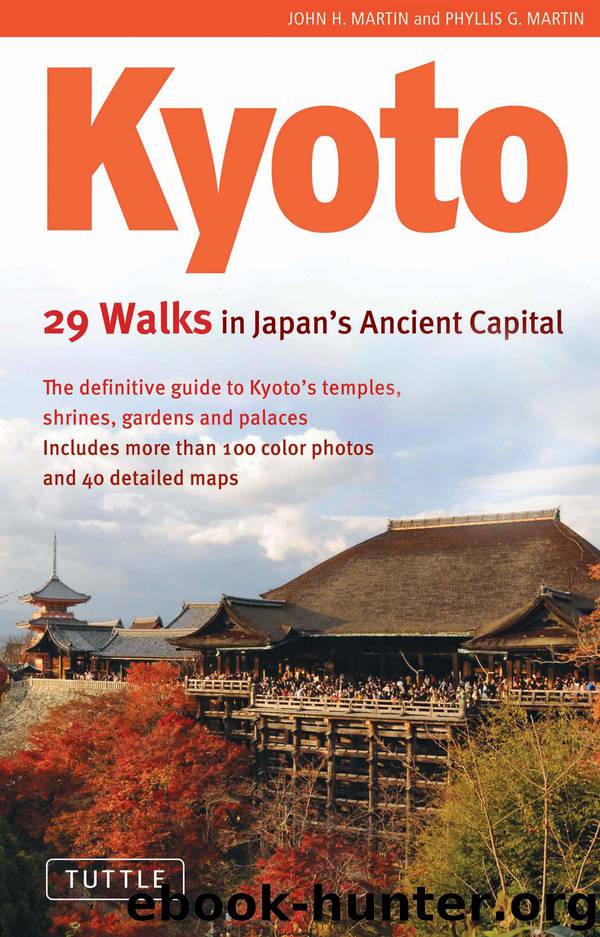Kyoto by John H. Martin

Author:John H. Martin [Martin, John H. & Martin, Phyllis G.]
Language: eng
Format: epub
ISBN: 978-1-4629-0635-2
Publisher: Tuttle Publishing
13 KOTO-IN TEMPLE
The Koto-in is just beyond the Soken-in and is noted for one of its tea rooms, its association with Sen-no-Rikyu and the story concerning the wife of the founder of this subtemple. Koto-in (High Paulownia Temple) lies beyond the Soken-in. The path in front of the Soken-in (walking westward) comes to an intersecting path; a left turn here brings you to Koto-in, the first temple on the west side of the north– south path. (It is open from 9:00 a.m. to 5:00 p.m. Entry fee. The Treasure House is open from November 1 to November 7 from 8:00 a.m. to 5:00 p.m. Entry fee.)
In 1601, Hosokawa Tadaoki (1563–1645) was one of the leading military men (and one of the few to survive the bloody wars of the 16th century) whose career spanned the years of rule by Oda Nobunaga, Toyotomi Hideyoshi and Tokugawa Ieyasu. Tadaoki, a man of intellectual attainments and taste, established the Koto-in in memory of his father. In 1619, he devoted himself to the study of Zen doctrine under Priest Seigan (1588–1661) of Daitoku-ji, and he became a Buddhist priest with the name of Sansai. The shoin of the Koto-in, once the residence of Sen-no-Rikyu, was moved here by Tadoki, one of Sen’s most distinguished disciples.
The main gate of the Koto-in Hondo leads to a path which turns on to a second, moss-bordered long stone path shaded by maple trees. A second gate leads to a bell-shaped window giving a view of the garden beyond as the path turns to lead to the south-facing Hondo. The present building was erected in the early 1900s to replace the original which was burned in the anti-Buddhist campaign of the Meiji era. At the ticket entry to the main building, the corridor to the left leads to the Hondo or Hojo (Main Hall), which faces on to the temple garden to the south. On the east side, an 8-mat room is followed by a 10-mat room, both with plain fusuma. As you turn the corner of the second room, you come to the main room of the Hondo, which opens at its rear to the altar room, with its tripartite division. In the right unit are two images of Shaka and one of Daruma (Chinese founder of Zen in the early 500s) and memorial tablets to past abbots. The central unit has a statue of Hosokawa Gyokuho, the founding abbot of the Koto-in and an uncle of Tadaoki, whom he appointed as the first priest of the temple. An image of Kannon is in a gold leaf zushi (shrine), with the four protecting Shi-tenno guardians painted on the shrine doors. The left unit has a statue of Tadaoki as well as the memorial tablets of the Hosokawa family.
The Hondo’s west rooms include the 8-mat tea room called Horai (Blessed Isles), which has a wash basin hollowed from a stone brought from the Korean Imperial Palace during Hideyoshi’s Korean wars of the 1590s, as well as a 10-mat room.
Download
This site does not store any files on its server. We only index and link to content provided by other sites. Please contact the content providers to delete copyright contents if any and email us, we'll remove relevant links or contents immediately.
China Rich Girlfriend by Kwan Kevin(3896)
The Silk Roads by Peter Frankopan(3763)
Annapurna by Maurice Herzog(2842)
Hot Thai Kitchen by Pailin Chongchitnant(2813)
Full Circle by Michael Palin(2772)
Okonomiyaki: Japanese Comfort Food by Saito Yoshio(2391)
City of Djinns: a year in Delhi by William Dalrymple(2136)
The Ogre by Doug Scott(2115)
Photographic Guide to the Birds of Indonesia by Strange Morten;(2089)
Tokyo by Rob Goss(2018)
Vietnam, Cambodia, Laos & Northern Thailand by Lonely Planet(2014)
Tokyo Geek's Guide: Manga, Anime, Gaming, Cosplay, Toys, Idols & More - The Ultimate Guide to Japan's Otaku Culture by Simone Gianni(1947)
Discover China Travel Guide by Lonely Planet(1866)
Everest the Cruel Way by Joe Tasker(1827)
China (Lonely Planet, 11th Edition)(1798)
Lonely Planet China(1755)
China Travel Guide by Lonely Planet(1741)
Top 10 Dubai and Abu Dhabi by DK Travel(1717)
Iranian Rappers And Persian Porn by Maslin Jamie(1710)
